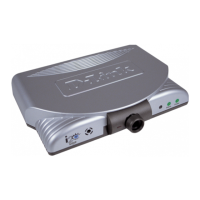56
Glossary of Terms
Bandwidth: A measure of the rate at which data can be sent and received
through a network. This value is usually given in bits per second (bps)
or mega bits per second (kbps).
CIF (Common Intermediate Format): An intermediate video format. When
DVC-1000 video is transmitted over a network, the sizes will be CIF,
QCIF, or SQCIF. The VideoPhone will default to CIF. CIF resolution is
352 x 288.
DHCP (Dynamic Host Configuration Protocol): A protocol that network
devices use to obtain an IP address, subnet mask, gateway and DNS
addresses automatically. A DHCP server can be a router, ISP server, or
PC running Internet connection sharing. See Static IP address.
Directory Service: A service that allows users to make videoconferencing
calls with telephone numbers. It does this by correlating telephone
numbers to actual public IP addresses.
DNS (Domain Name System): A system used to translate computer names
into IP addresses. For example, a DNS server would translate
www.dlink.com into 64.7.210.132.
DSL (Digital Subscribers Line): A technology that delivers digital information
at a high speed through a user’s telephone line. The most common
DSL is ADSL (Asymmetrical Digital Subscribers Line) where the
download speed is usually much higher than the upload speed.
Ethernet: The port on the back of the DVC-1000 VideoPhone that is used to
send and receive data over a network.
Far side: The remote connection of the videoconference. Your connection is
the Local Connection.
Firewall: A security mechanism placed between networks, which restricts
certain types of data to devices behind the firewall.
H.323: Standard defining videoconferencing over the Internet.

